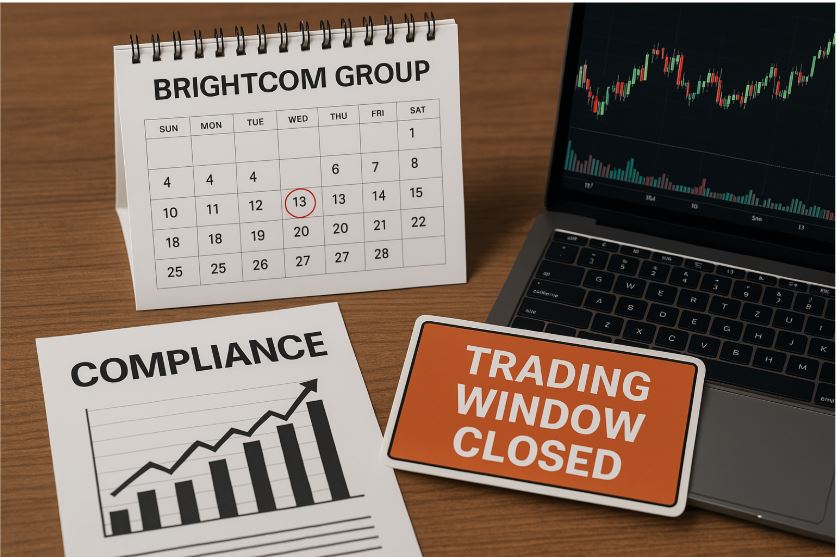
Brightcom Group Trading Window Closure: What Investors Need to Know
In the dynamic world of stock markets, transparency and compliance play a vital role in building investor trust. One of the common corporate practices that align with these principles is the trading window closure. Recently, market watchers and investors have been focusing on the Brightcom Group trading window closure, which has stirred curiosity and speculation. In this blog post, we’ll take a detailed look at what the Brightcom Group trading window closure means, why it’s significant, and what it implies for existing and potential investors.
What Is a Trading Window Closure?
Before diving into the Brightcom Group trading window closure, it’s essential to understand what a trading window closure is. In simple terms, a trading window closure is a time period when insiders of a company—such as directors, key managerial personnel, and employees—are not allowed to buy or sell the company’s shares. This regulation is enforced under SEBI’s (Securities and Exchange Board of India) Prohibition of Insider Trading norms.
The main goal is to prevent any potential misuse of unpublished price-sensitive information (UPSI). During this window, insiders must refrain from trading in the company’s securities to avoid any conflict of interest or suspicion of insider trading.
Understanding Brightcom Group and Its Market Presence
Brightcom Group is a digital marketing and advertising technology company that operates globally. With a focus on delivering comprehensive digital solutions to advertisers, agencies, and publishers, Brightcom Group has been a recognized name in the industry. Its operations span across programmatic advertising, AI-driven marketing strategies, and big data analytics.
Due to its wide market presence and its listing on major Indian stock exchanges, Brightcom Group regularly complies with regulatory guidelines, including the periodic announcement of Brightcom Group trading window closure dates.
Why Is the Brightcom Group Trading Window Closure Important?
The Brightcom Group trading window closure is important for several reasons:
-
Investor Protection: It ensures that all investors have a level playing field. By restricting insiders from trading during sensitive times, it builds trust in the company’s governance.
-
Regulatory Compliance: By announcing and adhering to the Brightcom Group trading window closure, the company demonstrates its commitment to following SEBI’s regulations.
-
Transparency: Regular updates about the Brightcom Group trading window closure reflect the company’s proactive approach toward corporate governance.
-
Signals Upcoming Events: In many cases, a trading window closure precedes the release of quarterly results, major acquisitions, or financial announcements. Hence, market participants often see this as a hint of upcoming developments.
When Does Brightcom Group Announce Trading Window Closures?
The Brightcom Group trading window closure typically occurs around the end of a financial quarter or before any major event involving price-sensitive information. According to standard industry practice and SEBI guidelines, the trading window is closed from the end of the quarter until 48 hours after the declaration of financial results.
For example, if the company is planning to announce its quarterly earnings in mid-May, the Brightcom Group trading window closure might begin as early as April 1st. This time frame ensures that no insider can take unfair advantage of unpublished financial data.
How Does It Affect Retail Investors?
While the Brightcom Group trading window closure directly affects insiders, it indirectly sends signals to retail investors. Here’s how:
-
Signals Financial Results or Major News: The closure is often a precursor to the release of financial results. This can be a critical time to observe the stock and its upcoming movement.
-
Promotes Confidence in Governance: Knowing that the company is following best practices like Brightcom Group trading window closure gives retail investors confidence in the stock’s governance and ethics.
-
Influences Stock Sentiment: Market speculation tends to rise during this period, and many investors take trading window closures as an indication of upcoming positive or negative news.
Best Practices for Investors During the Brightcom Group Trading Window Closure
If you are holding Brightcom Group shares or considering an investment, here are some best practices to follow during the Brightcom Group trading window closure:
1. Avoid Speculative Trades
Avoid making trading decisions solely based on the window closure. While it’s a signal of upcoming announcements, it’s not a sure indicator of performance.
2. Wait for Official Disclosures
Patience is key. Wait for the company to release its official earnings or news updates. The Brightcom Group trading window closure ensures that everyone gets access to information at the same time.
3. Track Regulatory Filings
Keep an eye on the Bombay Stock Exchange (BSE) or National Stock Exchange (NSE) announcements regarding Brightcom Group trading window closure and financial results. These updates help you make informed decisions.
4. Review Past Performance
Use this period to analyze the company’s past performance and anticipate potential market reactions to the upcoming announcements once the trading window reopens.
How Does Brightcom Group Communicate Trading Window Closures?
Brightcom Group communicates the trading window closure through stock exchange filings and official press releases. These notifications clearly mention:
-
Start and end date of the trading window closure
-
The reason for the closure (usually quarterly results)
-
Applicable employees and insiders
This clarity is a part of the company’s effort to remain transparent and SEBI-compliant.
Conclusion: Why You Should Watch the Brightcom Group Trading Window Closure
The Brightcom Group trading window closure is more than just a regulatory formality—it is a powerful indicator of the company’s operational transparency and ethical standards. For investors, both seasoned and new, understanding the significance of this closure period can help in timing market decisions better and staying on the right side of regulations.
With the rise of compliance awareness and growing investor scrutiny, companies like Brightcom Group continue to gain attention for their disciplined approach. So the next time you come across a Brightcom Group trading window closure notice, don’t ignore it. Instead, use it as an opportunity to reassess your investment strategy and stay informed.
Leave a Reply